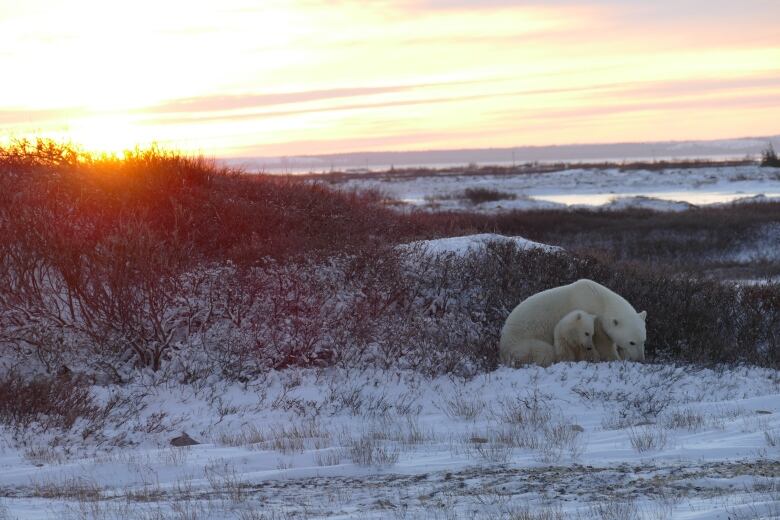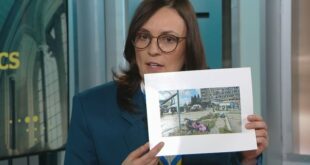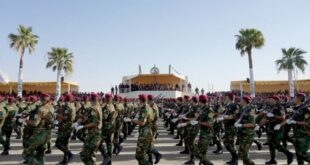Summer sea ice likely lost at 6 C of Arctic warming, says snow and ice expert

If we manage to cap global warming at 1.5 C since pre-industrial times, it'll be several degrees warmer in Canada's North. This is the third instalment of a series that looks at what six degrees of warmth will mean for the N.W.T. Read the first here, and the second here.
When David Kuptana looked out the window of his home in Ulukhaktok, N.W.T., and across the Beaufort Sea last Friday, he saw something unusual for November — open water, just two kilometres away.
"We never used to have that. We used to have frozen solid ice," he said.
Ulukhaktok, a small coastal community on the west bank of Victoria Island, is north of the Arctic Circle. It's where Kuptana, a full-time hunter, was born and raised.
Kuptana says warming temperatures in the Arctic mean ice is forming later in the season, limiting his capacity to travel to his usual hunting spots and also driving away some of the wildlife he's looking for — like polar bears and seals.
Both animals like pressure ridges in the ice, said Kuptana. It's where seals like to raise their young and, not so incidentally, where polar bears might find a meal. But the absence of thick ice and those pressure ridges, said Kuptana, means the absence of those animals too.
"The ice is too thin," he said.
Summer sea ice likely to disappear at 6 C
Seeing less sea ice is something Kuptana and others in Ulukhaktok may have to get used to. Even under best case scenarios, the world appears to be locked into rising temperatures that will affect the Arctic even more than the global average.
Studies show the Arctic is warming at four times the rate of the rest of the world. That means, even if global emissions are capped at 1.5 C, the Arctic could see temperatures up to 6 C warmer than they were in pre-industrial times.
Walt Meier, a senior research scientist at the University of Colorado Boulder's National Snow and Ice Data Centre, said at 6 C of warming — "we're pretty much guaranteed that the ice cover is going to go completely in the summertime."

Meier is referring to summer sea ice, sometimes referred to as multi-year ice. It's the ice that sticks around in the Arctic Ocean for more than a year, making it different from seasonal or annual sea ice.
A recently published report by the International Cryosphere Climate Initiative, delivered at the COP27 climate conference in Egypt earlier this month projects the Arctic will lose all its summer sea ice at least once before 2050.
Meier helped review the report. He said every degree counts.
If we're able to cap warming in the Arctic to 4.5 degrees, he said that'll probably preserve a couple million square kilometres of sea ice. That could be something of a lifeline for all the creatures that rely on the ice, like the polar bears that walk on top of it and the tiny organisms that exist below.
Loss of sea ice spells out doom for polar bears
The last time Kristin Laidre saw a polar bear hunt was from a helicopter over northeast Greenland.
Laidre, a principal scientist at the Polar Science Centre at the University of Washington, watched as the animal reared up on its hind legs and smashed down through a lumpy patch of snow — a seal den — over and over again.
"It keeps doing that to the point where like, the whole bear is almost like under the snow. You can only see its butt sticking up," she said.
But the hunt was unsuccessful. Laidre said a polar bear has to "work pretty hard" to catch a seal, its primary prey.
A research paper says that when polar bears come into communities for food, it threatens their health and their lives. Laidre also said the bears can't draw enough fat from eating things on the land — like berries or twigs — to survive.

Polar bears are a "specialist" in hunting on the frozen ocean, said Laidre. Each of its techniques for hunting seal hinges on the existence of sea ice.
And that's why the loss of summer sea ice spells out almost certain doom for the species.
"You would lose polar bears in most parts of their range," she said. "Now, might there be some polar bears that can hang on in some small areas like, for example, around Greenland, where we have some glaciers? Maybe. But I don't even know."
'It's going to hurt a lot of people'
In the 90s and 2000s, Kuptana said his community was able to hunt what they needed for the winter season in the months of October and September.
"We used to catch lots of animals for the whole winter," he said.
But now, because freeze-up happens later in the year, he heads out to hunt on the ice later in the year too. By the time the ice is safe to travel on, he said, the days have become short, and sometimes animals, like caribou, have migrated away already.
It means he's travelling further and with less daylight, to harvest food for his family.

"The gas price just went right up, right now, just on Monday," he said. "It's going to be very hard for our young people that got no income to try and harvest for their family," he said.
Kuptana says for a few years now, Ulukhatuk has been trading fish for caribou meat from Aklavik to help those struggling to get country meat.
"Our elders, my dad, used to tell me someday we're not going to see snow. And it's not gonna freeze, we're not gonna have ice. And it's starting to affect us, it's starting to happen," he said.
"My big fear is if the climate change continue[s] on and doing what it's doing right now, it's going to hurt a lot of people."
*****
Credit belongs to : www.cbc.ca
 MaharlikaNews | Canada Leading Online Filipino Newspaper Portal The No. 1 most engaged information website for Filipino – Canadian in Canada. MaharlikaNews.com received almost a quarter a million visitors in 2020.
MaharlikaNews | Canada Leading Online Filipino Newspaper Portal The No. 1 most engaged information website for Filipino – Canadian in Canada. MaharlikaNews.com received almost a quarter a million visitors in 2020.







